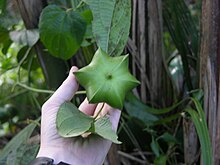Plukenetia volubilis: Difference between revisions
rm issues templates, article looks good |
NutriOmega (talk | contribs) Tag: possible conflict of interest |
||
| Line 38: | Line 38: | ||
*[http://internt.nhm.ac.uk/jdsml/research-curation/projects/linnaean-typification/detail.dsml?ID=685600&listPageURL=list%2edsml%3fVarqtype%3dstarts%2bwith%26CVarqtype%3dstarts%2bwith%26CGenusqtype%3dstarts%2bwith%26CSpeciesqtype%3dstarts%2bwith%26Species%3dvolubilis%26sort%3dGenus%252cSpecies%26Speciesqtype%3dstarts%2bwith%26Genus%3dPlukenetia%26Genusqtype%3dstarts%2bwith%26CSspqtype%3dstarts%2bwith The Linnaean Plant Name Typification Project] |
*[http://internt.nhm.ac.uk/jdsml/research-curation/projects/linnaean-typification/detail.dsml?ID=685600&listPageURL=list%2edsml%3fVarqtype%3dstarts%2bwith%26CVarqtype%3dstarts%2bwith%26CGenusqtype%3dstarts%2bwith%26CSpeciesqtype%3dstarts%2bwith%26Species%3dvolubilis%26sort%3dGenus%252cSpecies%26Speciesqtype%3dstarts%2bwith%26Genus%3dPlukenetia%26Genusqtype%3dstarts%2bwith%26CSspqtype%3dstarts%2bwith The Linnaean Plant Name Typification Project] |
||
*Guillen D. Maria, et al. "Characterization of Sacha Inchi (Plukenetia volubi L.) by FTIR Spectroscopy and 1H NMR. Comparison with Linseed Oil." ''Journal of the American Oil Chemists' Society''. 2003. |
*Guillen D. Maria, et al. "Characterization of Sacha Inchi (Plukenetia volubi L.) by FTIR Spectroscopy and 1H NMR. Comparison with Linseed Oil." ''Journal of the American Oil Chemists' Society''. 2003. |
||
http://www.nutriomega.com/ingles.html |
|||
[[Category:Euphorbiaceae]] |
[[Category:Euphorbiaceae]] |
||
Revision as of 21:50, 3 February 2011
| Plukenetia volubilis | |
|---|---|

| |
| Fruit of Plukenetia volubilis, Ecuador | |
| Scientific classification | |
| Kingdom: | |
| Division: | |
| Class: | |
| Order: | |
| Family: | |
| Subfamily: | |
| Tribe: | |
| Subtribe: | |
| Genus: | |
| Species: | P. volubilis
|
| Binomial name | |
| Plukenetia volubilis | |
Plukenetia volubilis, commonly known as Sacha Inchi, Sacha Peanut, Mountain Peanut or Inca-Peanut, is a perennial plant with somewhat hairy leaves, in the Euphorbiaceae. It is native to the Amazon Rainforest, where it has been cultivated by indigenous people for centuries, and will grow in warm climates up to altitudes of 1,700 meters (5,500 feet) as long as there continued availability of water and good drainage. It grows better in acidic soils, frank and alluvial flats near rivers.
The plant reaches a height of 2 m (6' 6"), with alternate, heart shaped, serrated leaves, 10 to 12 cm long (4"-4.7") and 8 to 10 cm (3.1-3.9") wide, that have petioles 2–6 cm (0.8-2.3") long. It flowers five months after being planted, and bears seeds around the eighth month. The male flowers are small, white, and arranged in clusters. Two female flowers are located at the base of the inflorescence.
The fruits are capsules of 3 to 5 cm in diameter with 4 to 7 points, are green and ripen blackish brown. It usually consists of four lobes, but some may have up to seven. Inside are the seeds, oval, dark-brown, 1.5 to 2 cm in diameter and 45 to 100 grams of weight. The cotyledons are open, similar to those of almonds, and covered with a whitish film.
The seeds of Inchi have high protein (27%) and oil (35 - 60%) content. Its oil is one of the largest plant sources of the Omega family of fatty acids, an essential for human life. It contains Omega 3 (48%), Omega 6 (36%), Omega 9 (9%), and protein (27%). They are also rich in iodine and vitamin A and vitamin E.
Modern Uses
Sacha Inchi oil production is increasing in the Peruvian Amazon and is gaining international recognition for its taste and health properties. In June 2007, Sacha Inchi oil won the Médaille d'or (Gold Medal) at the AVPA[1] Specialty Foods Commodities competition. Sacha Inchi has been called a super food because of its high content of essential fatty acids. The oil has a mild flavour, not bitter, with a nutty finish. With new research emphasizing the health benefits of Omega fatty acids, interest in sustainable sources of Omega is increasing. Sacha Inchi oil is used in vegetarian diets to provide a plant source for Omega-3 fatty acids.
Humanitarian group Oxfam and a group called SEPAR are collaborating to develop techniques for growing Sacha Inchi. Used as a cash crop, Sacha Inchi is bringing money to rural areas and allowing indigenous groups like the Ashaninka to stay in villages.[1]
References
- ^ Hufstader, Chris (Winter 2009). "Looking to Sacha Inchi for their future". Oxfam Exchange. 9 (1): 2–3.
External links
- Sacha Inchi (Plukenetia volubilis, Euphorbiaceae): A Promising Oilseed Crop from Peruvian Amazon
- Biodiversity International: Species Database
- USDA Agricultural Research Service Taxonomy
- The Linnaean Plant Name Typification Project
- Guillen D. Maria, et al. "Characterization of Sacha Inchi (Plukenetia volubi L.) by FTIR Spectroscopy and 1H NMR. Comparison with Linseed Oil." Journal of the American Oil Chemists' Society. 2003.
